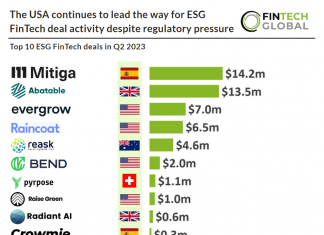The implementation deadline of European Sustainability Reporting Standards (ESRS) is just around the corner, but are firms ready?
The regulation is part of the European Corporate Sustainability Reporting Directive (CSRD), which aims to introduce new reporting requirements for large companies and listed SMEs operating within the EU.
ESRS will expand the current scope of sustainability reporting standards. In its initial form, it comprises 12 standards that outline the reporting requirements of CSRD. Two of these standards focus on the general requirements that apply to all topics within CSRD and the remaining ten focus on specific areas, including climate change, pollution, water and marine resources, biodiversity, workers in the value chain, business conduct and more.
Both the CSRD and ESRS went into effect on January 1st 2024. At the end of the fiscal year 2024, the companies, banks and insurance already covered by the Non-Financial Reporting Directive (NFRD) will have to complete their first set of sustainability reports. As part of a phased implementation, in 2026, larger companies not under the NFRD will have to complete their first reports for the fiscal year 2025. Finally, listed SMEs on public markets will need to file their first reports in 2027 for the 2026 fiscal year, and non-EU companies with significant operations in the EU must complete their first report in 2029 for the 2028 fiscal year. Helpful guides on the requirements of ESRS can be found from Greenomy and Position Green.
As we enter the first implementation stage of the regulation, it begs the question of whether firms are ready. Sarah Lokman – the head of sustainability at ESG reporting software developer Greenomy – believes many companies are still at the stage of understanding and evaluating the scope of the regulation, the reporting requirements and exemptions of the CSRD.
She said, “They are analysing their organisational structure to determine which entities fall under the CSRD stage or phase-in. Regardless of whether a company is a parent or subsidiary, it’s essential to grasp the full scope of the CSRD for the entire organisation.
“A company’s readiness for CSRD largely hinges on its maturity level. While many of them, who have disclosed their GRI reporting, are in a favourable position to transition to ESRS reporting, some have already established processes to evaluate and collect sustainability data.”
Olivia Krall, manager at Position Green, also indicated that some firms are behind where they should be. She said, “In general, there are large gaps between the ESRS and what companies are currently disclosing in their sustainability reporting. For example, Position Green’s 2023 ESG100 analysis found that only 54% of the core ESRS disclosures were reported by the top 300 listed companies in Denmark, Norway and Sweden in 2022.
“While the ESRS builds upon existing sustainability reporting standards such as GRI, TCFD and the GHG Protocol, the ESRS goes much further when it comes to the level of detail needed in the disclosed information, while also adding the financial perspective.”
Misconceptions with the regulation
As with any new regulation, it is easy for misconceptions to occur, particularly when they cover a large area. ESRS is no different and so it is vital executives and compliance teams are fully aware of the rules and what they must do.
One of the biggest mistakes that Greenomy’s Lokman has seen within the market is a misjudgement in the amount of work it requires to implement the data collection and reporting processes. She added, “Companies can opt out of disclosing the anticipated financial effects and for impacts, risks and opportunities for the first year. Certain disclosures related to the workforce can also be omitted in the first year under certain conditions.”
Another common misconception is with the scope of ESRS. The regulation encompasses a lot of companies and from 2028, even non-EU companies will have to adhere to the regulations if they are deemed to have significant operations in the EU.
This ties in with another mistake that firms might be making with the regulation. There are a number of phase-in elements for ESRS and it can be easy for timelines to get mixed and cause errors. Position Green’s Krall said, “There are a number of phase-in elements in the ESRS. For example, all companies may omit upstream and downstream value chain information in their metrics during the first three years. Furthermore, companies with less than 750 employees are subject to additional phase-in disclosures and data points during the first two years.”
Advice for firms
There is still time for firms to get their systems ready for their sustainability reporting needs, but time is running out.
One of the biggest aspects of the ESRS regulation is the double materiality assessment. This is a method to help firms understand if something needs to be included within the sustainability reports. It covers impact materiality, which assesses a business’ operations and value chain and whether it has a positive or negative impact on people or the environment. The other half of the double materiality assessment is the financial materiality. This examines whether a business’ sustainability matter generates risks or opportunities that affect, or could affect, their financial position, financial performance, cash flows, access to finance or cost of capital. If a sustainability matter triggers either of these sides of the double materiality assessment, it will need to be reported on.
Position Green’s Krall advised firms to complete a double materiality assessment as a matter of urgency. Once completed, they can identify any ‘low-hanging fruit’ for early reporting, as well as adjust internal processes to prepare them for ESRS. She added, “Even though value chain information is being phased in, we recommend that companies start working with and collecting information from your value chain already now. We also recommend getting started on developing policies and action plans for material impacts, risks and opportunities, as well as setting baselines and targets.”
As for Greenomy’s Lokman, she urged firms to focus on the urgent matters first. While areas cannot be skipped, some sustainability topics will require more work and getting started earlier will be very beneficial. She said, “Major companies should immediately address relevant social and environmental data to their sectors, prioritising urgent issues like GHG emissions calculation, the workforce, governance around sustainability etc. While all sustainability topics under ESRS are crucial, certain requirements demand more immediate focus. This involves a careful balance between collecting relevant data and meeting the practical needs of businesses.”
One final piece of advice was provided by IBOS Association managing director Manoj Mistry. He said, “Companies should start preparing now for enhanced sustainability reporting as the European Commission has published the final text of its first set of twelve European Sustainability Reporting Standards (ESRSs). They should assess which topics to report using the double materiality concept and ensure they have the data, processes, and expertise to report on topics that may be new to them.”
Support from the market
As companies look to get their systems ready for the incoming regulation, Greenomy and Position Green both offer the services to help firms prepare themselves.
Position Green offers ESG software that helps companies to accelerate their sustainability transformation. Its technology covers sustainability reporting, supplier assessment and sustainable investment due diligence and monitoring. As part of its ESRS support, Position Green offers an all-in-one solution powered through a dashboard to help manage all the various functions.
The ESRS software helps clients simplify and optimise their ESG data management through built-in structures allowing relevant data to be easily collated from across the organisation. Some of its features include double materiality assessments, data consolidation for ESRS reporting and sustainability statements. This is all topped off with full transparency as required for limited assurance under the CSRD.
Krall added, “Our advisory team can support companies with performing double materiality assessments and gap analysis, developing their organisational setup and capabilities, and adjusting reporting and other ESG work to reflect the ESRS. Companies can also prepare their organisation with our instructor-led training or curated e-learning focused on the CSRD and ESRS.”
As for Greenomy, the company offers AI-driven sustainability reporting software that supports compliance with CSRD, EU Taxonomy, ISSB and any future related standard. Its SaaS portal unifies complex regulatory demands into a single data model that is fortified by ESG data libraries and generative AI. This allows clients to simplify the creation of sustainability reports and allow teams to focus on more important tasks. To help with the challenges that corporates are facing, Greenomy also offers advisory services to support them on each phase of their ESG reporting journey such as CSRD readiness, a Double Materiality Assessment or Gap Analysis to full CSRD reporting.
Lokman noted that as the first companies will be required to report under the CSRD in 2025, firms should start working on their compliance processes. Greenomy’s CSRD accelerator programme will help firms do that.
She said, “In the Greenomy CSRD Accelerator, our Sustainability Advisory team helps you efficiently and affordably fast-track your CSRD reporting journey. You will develop a clear plan to implement your CSRD reporting strategy, ensuring ongoing compliance for the years to come.”
“Throughout the project, our team of regulatory, ESG data, and sustainability advisors will support you at every step. You will also have the chance to assess Greenomy’s pioneering CSRD module that digitises data capture and reporting to reduce your compliance workload in the long run.”
Keep up with all the latest FinTech news here.
Copyright © 2023 FinTech Global










